Analysis of Tendering, Estimating & Cost Control Techniques
VerifiedAdded on 2021/04/21
|12
|3584
|59
Report
AI Summary
This report comprehensively examines tendering processes, approximate estimation methods, and cost control techniques within construction projects. It details three approximate estimation methods: the square/plinth area method, the cubic meter method, and the approximate quantities with bill method, highlighting their applications and assumptions. The report then delves into the best tendering method, outlining the steps from pre-qualification questionnaires to contract execution, including the importance of a detailed invitation to tender document, clarification interviews, and the submission and appraisal of bids. Furthermore, the report emphasizes the significance of vetting contractors and service providers, focusing on their transactional or relationship-based approach, technical execution plans, credentials, equipment, and safety protocols. The overall goal is to provide a framework for achieving competitive pricing, effective project planning, and successful construction outcomes, with attention to key factors such as cost control, contractor selection, and project management.

TENDERING ESTIMATING & COST CONTROL
Name
Date
1
Name
Date
1
Paraphrase This Document
Need a fresh take? Get an instant paraphrase of this document with our AI Paraphraser
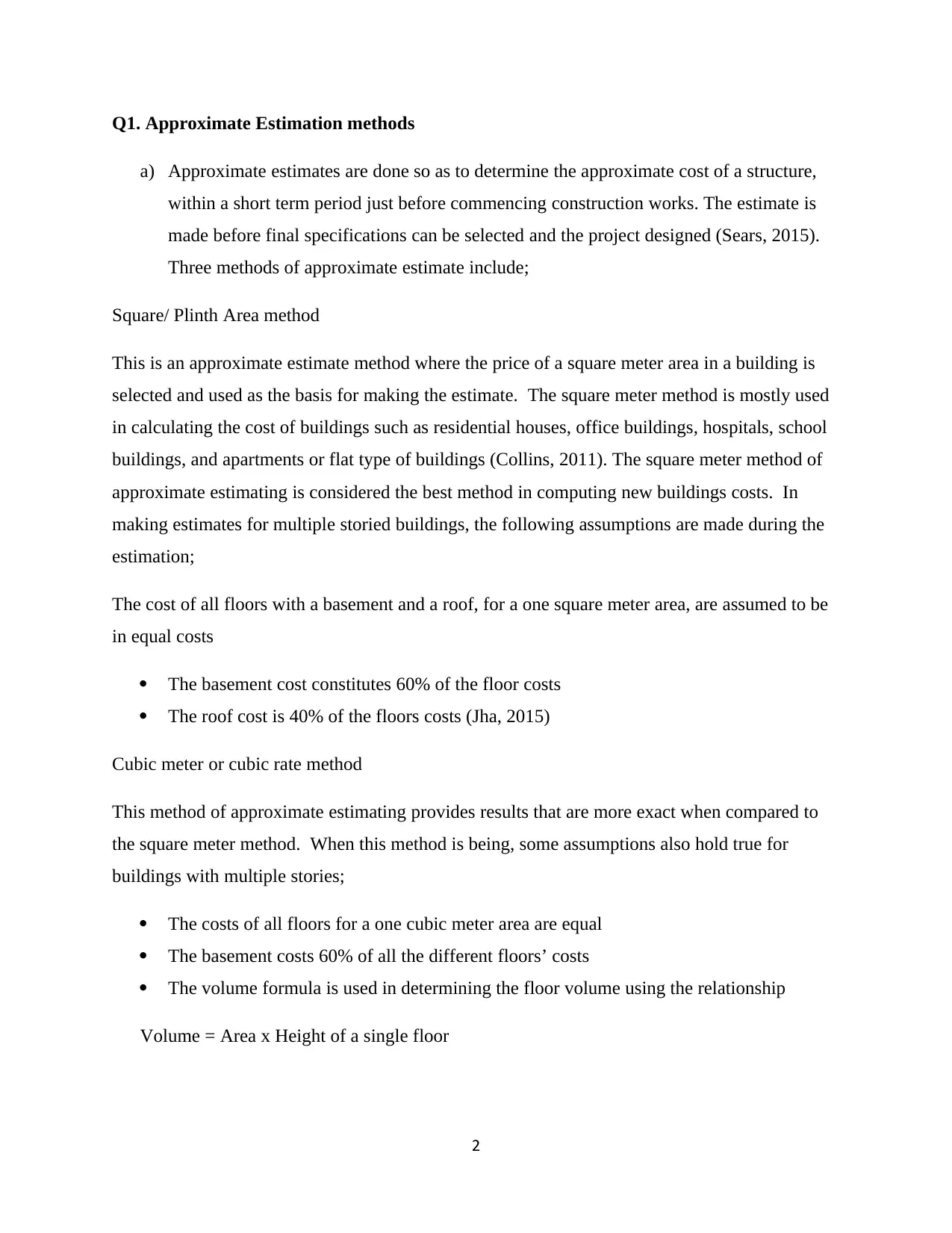
Q1. Approximate Estimation methods
a) Approximate estimates are done so as to determine the approximate cost of a structure,
within a short term period just before commencing construction works. The estimate is
made before final specifications can be selected and the project designed (Sears, 2015).
Three methods of approximate estimate include;
Square/ Plinth Area method
This is an approximate estimate method where the price of a square meter area in a building is
selected and used as the basis for making the estimate. The square meter method is mostly used
in calculating the cost of buildings such as residential houses, office buildings, hospitals, school
buildings, and apartments or flat type of buildings (Collins, 2011). The square meter method of
approximate estimating is considered the best method in computing new buildings costs. In
making estimates for multiple storied buildings, the following assumptions are made during the
estimation;
The cost of all floors with a basement and a roof, for a one square meter area, are assumed to be
in equal costs
The basement cost constitutes 60% of the floor costs
The roof cost is 40% of the floors costs (Jha, 2015)
Cubic meter or cubic rate method
This method of approximate estimating provides results that are more exact when compared to
the square meter method. When this method is being, some assumptions also hold true for
buildings with multiple stories;
The costs of all floors for a one cubic meter area are equal
The basement costs 60% of all the different floors’ costs
The volume formula is used in determining the floor volume using the relationship
Volume = Area x Height of a single floor
2
a) Approximate estimates are done so as to determine the approximate cost of a structure,
within a short term period just before commencing construction works. The estimate is
made before final specifications can be selected and the project designed (Sears, 2015).
Three methods of approximate estimate include;
Square/ Plinth Area method
This is an approximate estimate method where the price of a square meter area in a building is
selected and used as the basis for making the estimate. The square meter method is mostly used
in calculating the cost of buildings such as residential houses, office buildings, hospitals, school
buildings, and apartments or flat type of buildings (Collins, 2011). The square meter method of
approximate estimating is considered the best method in computing new buildings costs. In
making estimates for multiple storied buildings, the following assumptions are made during the
estimation;
The cost of all floors with a basement and a roof, for a one square meter area, are assumed to be
in equal costs
The basement cost constitutes 60% of the floor costs
The roof cost is 40% of the floors costs (Jha, 2015)
Cubic meter or cubic rate method
This method of approximate estimating provides results that are more exact when compared to
the square meter method. When this method is being, some assumptions also hold true for
buildings with multiple stories;
The costs of all floors for a one cubic meter area are equal
The basement costs 60% of all the different floors’ costs
The volume formula is used in determining the floor volume using the relationship
Volume = Area x Height of a single floor
2
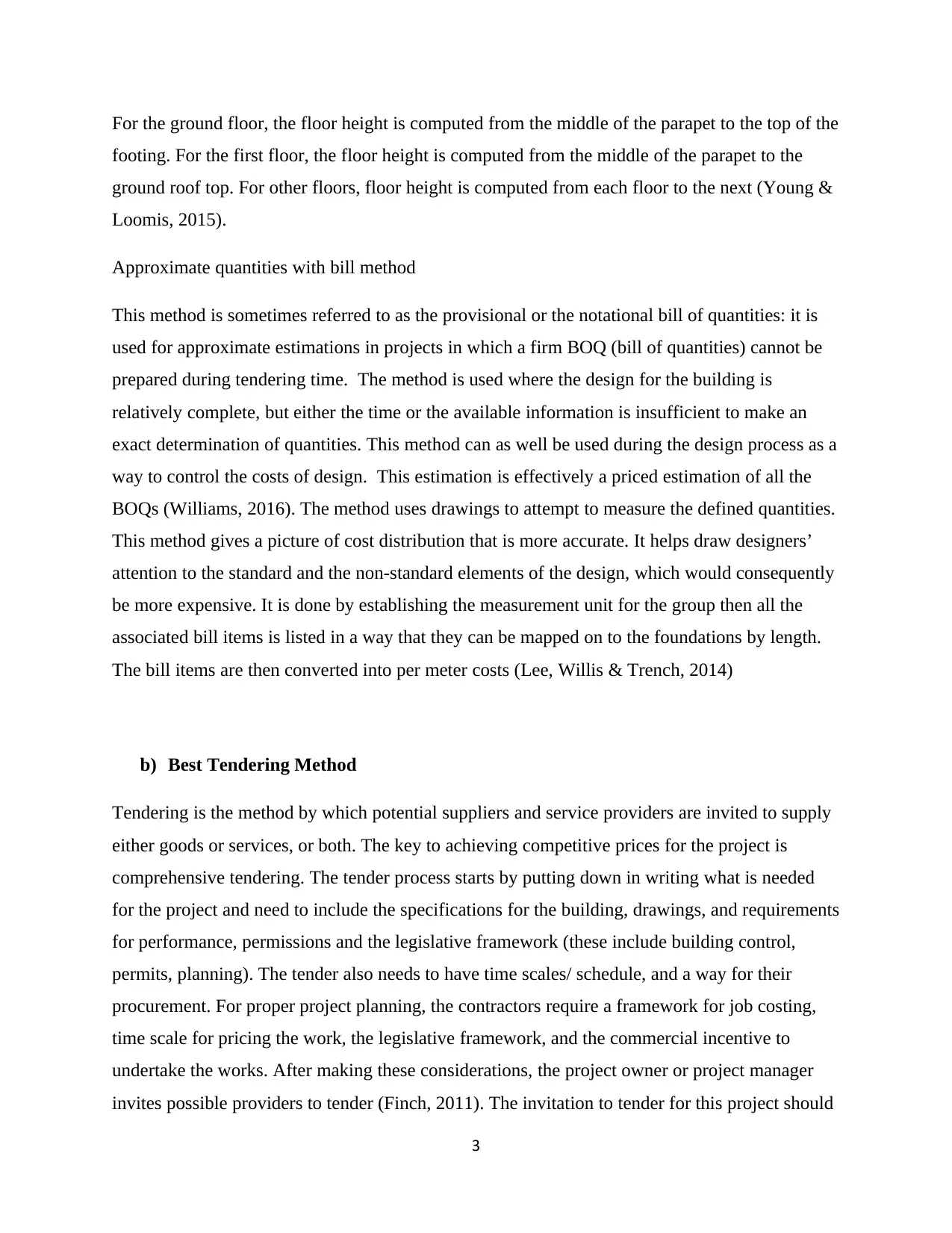
For the ground floor, the floor height is computed from the middle of the parapet to the top of the
footing. For the first floor, the floor height is computed from the middle of the parapet to the
ground roof top. For other floors, floor height is computed from each floor to the next (Young &
Loomis, 2015).
Approximate quantities with bill method
This method is sometimes referred to as the provisional or the notational bill of quantities: it is
used for approximate estimations in projects in which a firm BOQ (bill of quantities) cannot be
prepared during tendering time. The method is used where the design for the building is
relatively complete, but either the time or the available information is insufficient to make an
exact determination of quantities. This method can as well be used during the design process as a
way to control the costs of design. This estimation is effectively a priced estimation of all the
BOQs (Williams, 2016). The method uses drawings to attempt to measure the defined quantities.
This method gives a picture of cost distribution that is more accurate. It helps draw designers’
attention to the standard and the non-standard elements of the design, which would consequently
be more expensive. It is done by establishing the measurement unit for the group then all the
associated bill items is listed in a way that they can be mapped on to the foundations by length.
The bill items are then converted into per meter costs (Lee, Willis & Trench, 2014)
b) Best Tendering Method
Tendering is the method by which potential suppliers and service providers are invited to supply
either goods or services, or both. The key to achieving competitive prices for the project is
comprehensive tendering. The tender process starts by putting down in writing what is needed
for the project and need to include the specifications for the building, drawings, and requirements
for performance, permissions and the legislative framework (these include building control,
permits, planning). The tender also needs to have time scales/ schedule, and a way for their
procurement. For proper project planning, the contractors require a framework for job costing,
time scale for pricing the work, the legislative framework, and the commercial incentive to
undertake the works. After making these considerations, the project owner or project manager
invites possible providers to tender (Finch, 2011). The invitation to tender for this project should
3
footing. For the first floor, the floor height is computed from the middle of the parapet to the
ground roof top. For other floors, floor height is computed from each floor to the next (Young &
Loomis, 2015).
Approximate quantities with bill method
This method is sometimes referred to as the provisional or the notational bill of quantities: it is
used for approximate estimations in projects in which a firm BOQ (bill of quantities) cannot be
prepared during tendering time. The method is used where the design for the building is
relatively complete, but either the time or the available information is insufficient to make an
exact determination of quantities. This method can as well be used during the design process as a
way to control the costs of design. This estimation is effectively a priced estimation of all the
BOQs (Williams, 2016). The method uses drawings to attempt to measure the defined quantities.
This method gives a picture of cost distribution that is more accurate. It helps draw designers’
attention to the standard and the non-standard elements of the design, which would consequently
be more expensive. It is done by establishing the measurement unit for the group then all the
associated bill items is listed in a way that they can be mapped on to the foundations by length.
The bill items are then converted into per meter costs (Lee, Willis & Trench, 2014)
b) Best Tendering Method
Tendering is the method by which potential suppliers and service providers are invited to supply
either goods or services, or both. The key to achieving competitive prices for the project is
comprehensive tendering. The tender process starts by putting down in writing what is needed
for the project and need to include the specifications for the building, drawings, and requirements
for performance, permissions and the legislative framework (these include building control,
permits, planning). The tender also needs to have time scales/ schedule, and a way for their
procurement. For proper project planning, the contractors require a framework for job costing,
time scale for pricing the work, the legislative framework, and the commercial incentive to
undertake the works. After making these considerations, the project owner or project manager
invites possible providers to tender (Finch, 2011). The invitation to tender for this project should
3
⊘ This is a preview!⊘
Do you want full access?
Subscribe today to unlock all pages.

Trusted by 1+ million students worldwide
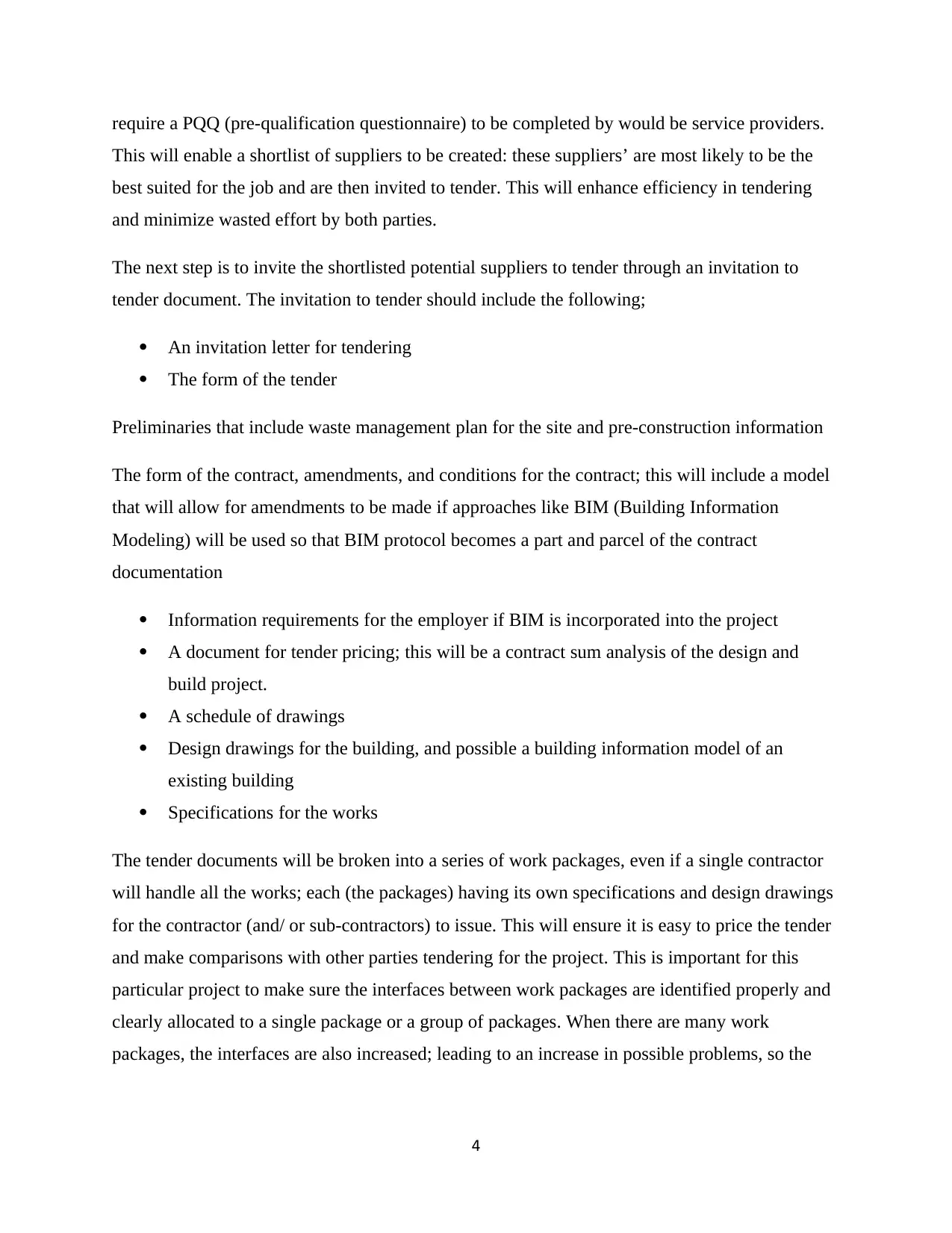
require a PQQ (pre-qualification questionnaire) to be completed by would be service providers.
This will enable a shortlist of suppliers to be created: these suppliers’ are most likely to be the
best suited for the job and are then invited to tender. This will enhance efficiency in tendering
and minimize wasted effort by both parties.
The next step is to invite the shortlisted potential suppliers to tender through an invitation to
tender document. The invitation to tender should include the following;
An invitation letter for tendering
The form of the tender
Preliminaries that include waste management plan for the site and pre-construction information
The form of the contract, amendments, and conditions for the contract; this will include a model
that will allow for amendments to be made if approaches like BIM (Building Information
Modeling) will be used so that BIM protocol becomes a part and parcel of the contract
documentation
Information requirements for the employer if BIM is incorporated into the project
A document for tender pricing; this will be a contract sum analysis of the design and
build project.
A schedule of drawings
Design drawings for the building, and possible a building information model of an
existing building
Specifications for the works
The tender documents will be broken into a series of work packages, even if a single contractor
will handle all the works; each (the packages) having its own specifications and design drawings
for the contractor (and/ or sub-contractors) to issue. This will ensure it is easy to price the tender
and make comparisons with other parties tendering for the project. This is important for this
particular project to make sure the interfaces between work packages are identified properly and
clearly allocated to a single package or a group of packages. When there are many work
packages, the interfaces are also increased; leading to an increase in possible problems, so the
4
This will enable a shortlist of suppliers to be created: these suppliers’ are most likely to be the
best suited for the job and are then invited to tender. This will enhance efficiency in tendering
and minimize wasted effort by both parties.
The next step is to invite the shortlisted potential suppliers to tender through an invitation to
tender document. The invitation to tender should include the following;
An invitation letter for tendering
The form of the tender
Preliminaries that include waste management plan for the site and pre-construction information
The form of the contract, amendments, and conditions for the contract; this will include a model
that will allow for amendments to be made if approaches like BIM (Building Information
Modeling) will be used so that BIM protocol becomes a part and parcel of the contract
documentation
Information requirements for the employer if BIM is incorporated into the project
A document for tender pricing; this will be a contract sum analysis of the design and
build project.
A schedule of drawings
Design drawings for the building, and possible a building information model of an
existing building
Specifications for the works
The tender documents will be broken into a series of work packages, even if a single contractor
will handle all the works; each (the packages) having its own specifications and design drawings
for the contractor (and/ or sub-contractors) to issue. This will ensure it is easy to price the tender
and make comparisons with other parties tendering for the project. This is important for this
particular project to make sure the interfaces between work packages are identified properly and
clearly allocated to a single package or a group of packages. When there are many work
packages, the interfaces are also increased; leading to an increase in possible problems, so the
4
Paraphrase This Document
Need a fresh take? Get an instant paraphrase of this document with our AI Paraphraser
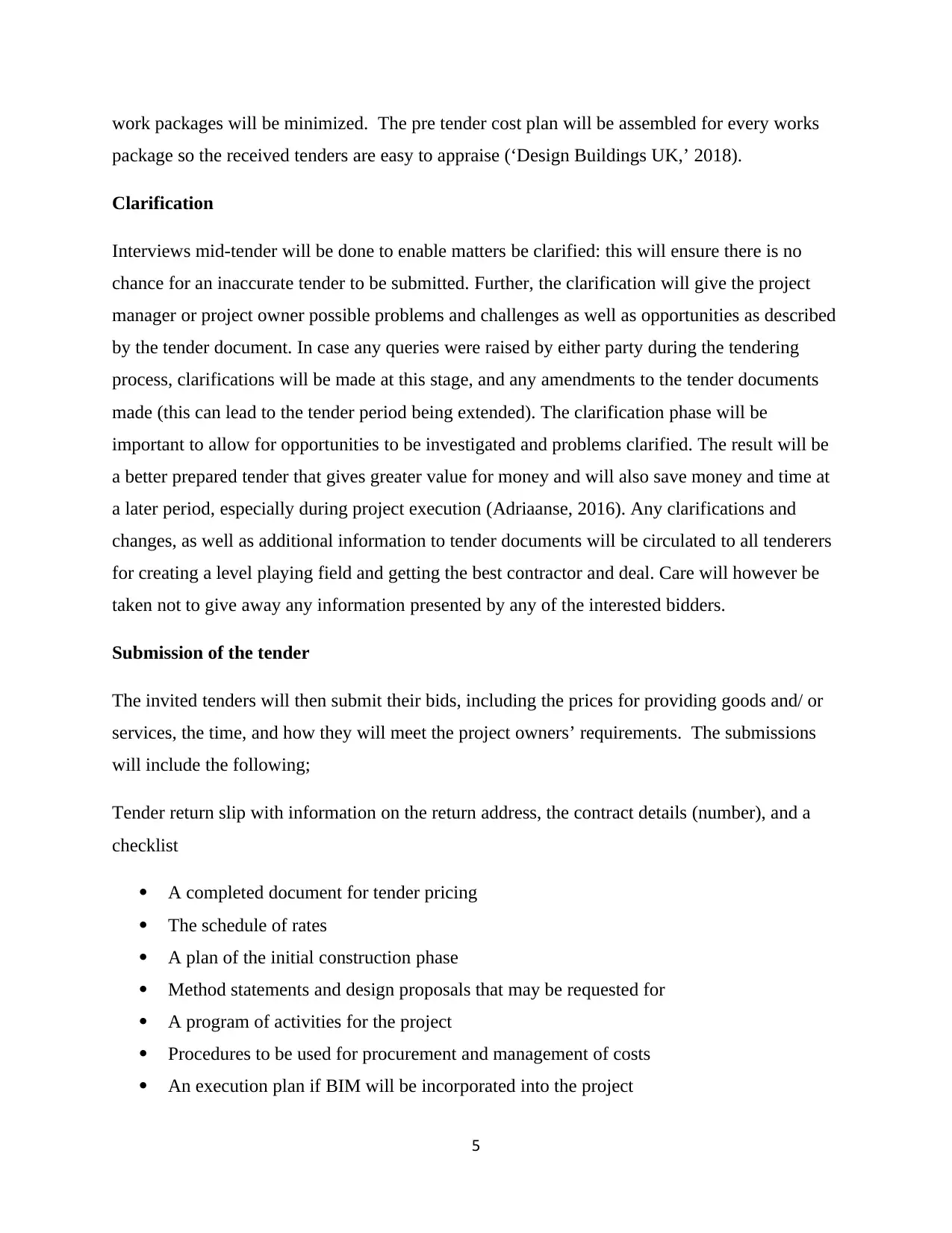
work packages will be minimized. The pre tender cost plan will be assembled for every works
package so the received tenders are easy to appraise (‘Design Buildings UK,’ 2018).
Clarification
Interviews mid-tender will be done to enable matters be clarified: this will ensure there is no
chance for an inaccurate tender to be submitted. Further, the clarification will give the project
manager or project owner possible problems and challenges as well as opportunities as described
by the tender document. In case any queries were raised by either party during the tendering
process, clarifications will be made at this stage, and any amendments to the tender documents
made (this can lead to the tender period being extended). The clarification phase will be
important to allow for opportunities to be investigated and problems clarified. The result will be
a better prepared tender that gives greater value for money and will also save money and time at
a later period, especially during project execution (Adriaanse, 2016). Any clarifications and
changes, as well as additional information to tender documents will be circulated to all tenderers
for creating a level playing field and getting the best contractor and deal. Care will however be
taken not to give away any information presented by any of the interested bidders.
Submission of the tender
The invited tenders will then submit their bids, including the prices for providing goods and/ or
services, the time, and how they will meet the project owners’ requirements. The submissions
will include the following;
Tender return slip with information on the return address, the contract details (number), and a
checklist
A completed document for tender pricing
The schedule of rates
A plan of the initial construction phase
Method statements and design proposals that may be requested for
A program of activities for the project
Procedures to be used for procurement and management of costs
An execution plan if BIM will be incorporated into the project
5
package so the received tenders are easy to appraise (‘Design Buildings UK,’ 2018).
Clarification
Interviews mid-tender will be done to enable matters be clarified: this will ensure there is no
chance for an inaccurate tender to be submitted. Further, the clarification will give the project
manager or project owner possible problems and challenges as well as opportunities as described
by the tender document. In case any queries were raised by either party during the tendering
process, clarifications will be made at this stage, and any amendments to the tender documents
made (this can lead to the tender period being extended). The clarification phase will be
important to allow for opportunities to be investigated and problems clarified. The result will be
a better prepared tender that gives greater value for money and will also save money and time at
a later period, especially during project execution (Adriaanse, 2016). Any clarifications and
changes, as well as additional information to tender documents will be circulated to all tenderers
for creating a level playing field and getting the best contractor and deal. Care will however be
taken not to give away any information presented by any of the interested bidders.
Submission of the tender
The invited tenders will then submit their bids, including the prices for providing goods and/ or
services, the time, and how they will meet the project owners’ requirements. The submissions
will include the following;
Tender return slip with information on the return address, the contract details (number), and a
checklist
A completed document for tender pricing
The schedule of rates
A plan of the initial construction phase
Method statements and design proposals that may be requested for
A program of activities for the project
Procedures to be used for procurement and management of costs
An execution plan if BIM will be incorporated into the project
5
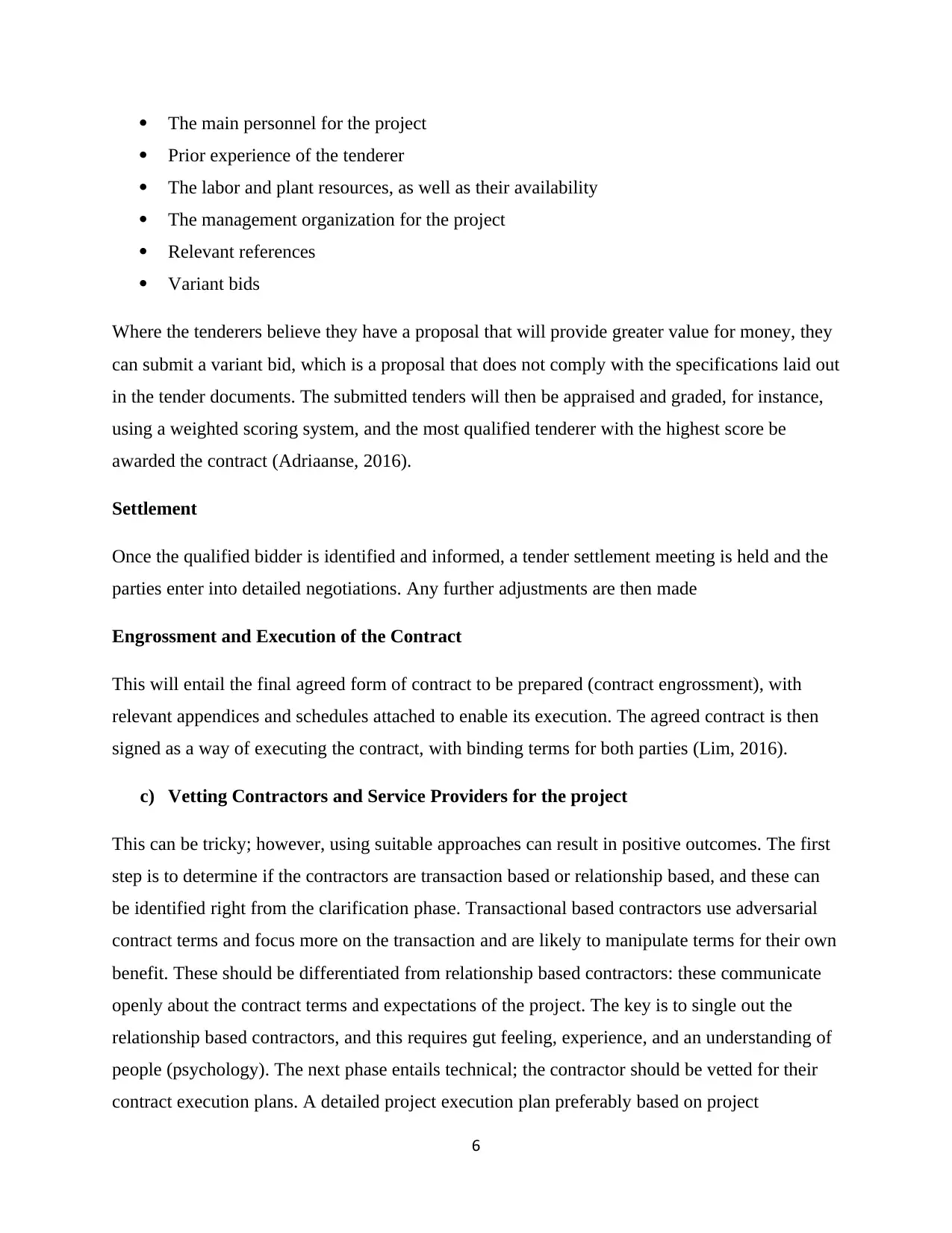
The main personnel for the project
Prior experience of the tenderer
The labor and plant resources, as well as their availability
The management organization for the project
Relevant references
Variant bids
Where the tenderers believe they have a proposal that will provide greater value for money, they
can submit a variant bid, which is a proposal that does not comply with the specifications laid out
in the tender documents. The submitted tenders will then be appraised and graded, for instance,
using a weighted scoring system, and the most qualified tenderer with the highest score be
awarded the contract (Adriaanse, 2016).
Settlement
Once the qualified bidder is identified and informed, a tender settlement meeting is held and the
parties enter into detailed negotiations. Any further adjustments are then made
Engrossment and Execution of the Contract
This will entail the final agreed form of contract to be prepared (contract engrossment), with
relevant appendices and schedules attached to enable its execution. The agreed contract is then
signed as a way of executing the contract, with binding terms for both parties (Lim, 2016).
c) Vetting Contractors and Service Providers for the project
This can be tricky; however, using suitable approaches can result in positive outcomes. The first
step is to determine if the contractors are transaction based or relationship based, and these can
be identified right from the clarification phase. Transactional based contractors use adversarial
contract terms and focus more on the transaction and are likely to manipulate terms for their own
benefit. These should be differentiated from relationship based contractors: these communicate
openly about the contract terms and expectations of the project. The key is to single out the
relationship based contractors, and this requires gut feeling, experience, and an understanding of
people (psychology). The next phase entails technical; the contractor should be vetted for their
contract execution plans. A detailed project execution plan preferably based on project
6
Prior experience of the tenderer
The labor and plant resources, as well as their availability
The management organization for the project
Relevant references
Variant bids
Where the tenderers believe they have a proposal that will provide greater value for money, they
can submit a variant bid, which is a proposal that does not comply with the specifications laid out
in the tender documents. The submitted tenders will then be appraised and graded, for instance,
using a weighted scoring system, and the most qualified tenderer with the highest score be
awarded the contract (Adriaanse, 2016).
Settlement
Once the qualified bidder is identified and informed, a tender settlement meeting is held and the
parties enter into detailed negotiations. Any further adjustments are then made
Engrossment and Execution of the Contract
This will entail the final agreed form of contract to be prepared (contract engrossment), with
relevant appendices and schedules attached to enable its execution. The agreed contract is then
signed as a way of executing the contract, with binding terms for both parties (Lim, 2016).
c) Vetting Contractors and Service Providers for the project
This can be tricky; however, using suitable approaches can result in positive outcomes. The first
step is to determine if the contractors are transaction based or relationship based, and these can
be identified right from the clarification phase. Transactional based contractors use adversarial
contract terms and focus more on the transaction and are likely to manipulate terms for their own
benefit. These should be differentiated from relationship based contractors: these communicate
openly about the contract terms and expectations of the project. The key is to single out the
relationship based contractors, and this requires gut feeling, experience, and an understanding of
people (psychology). The next phase entails technical; the contractor should be vetted for their
contract execution plans. A detailed project execution plan preferably based on project
6
⊘ This is a preview!⊘
Do you want full access?
Subscribe today to unlock all pages.

Trusted by 1+ million students worldwide
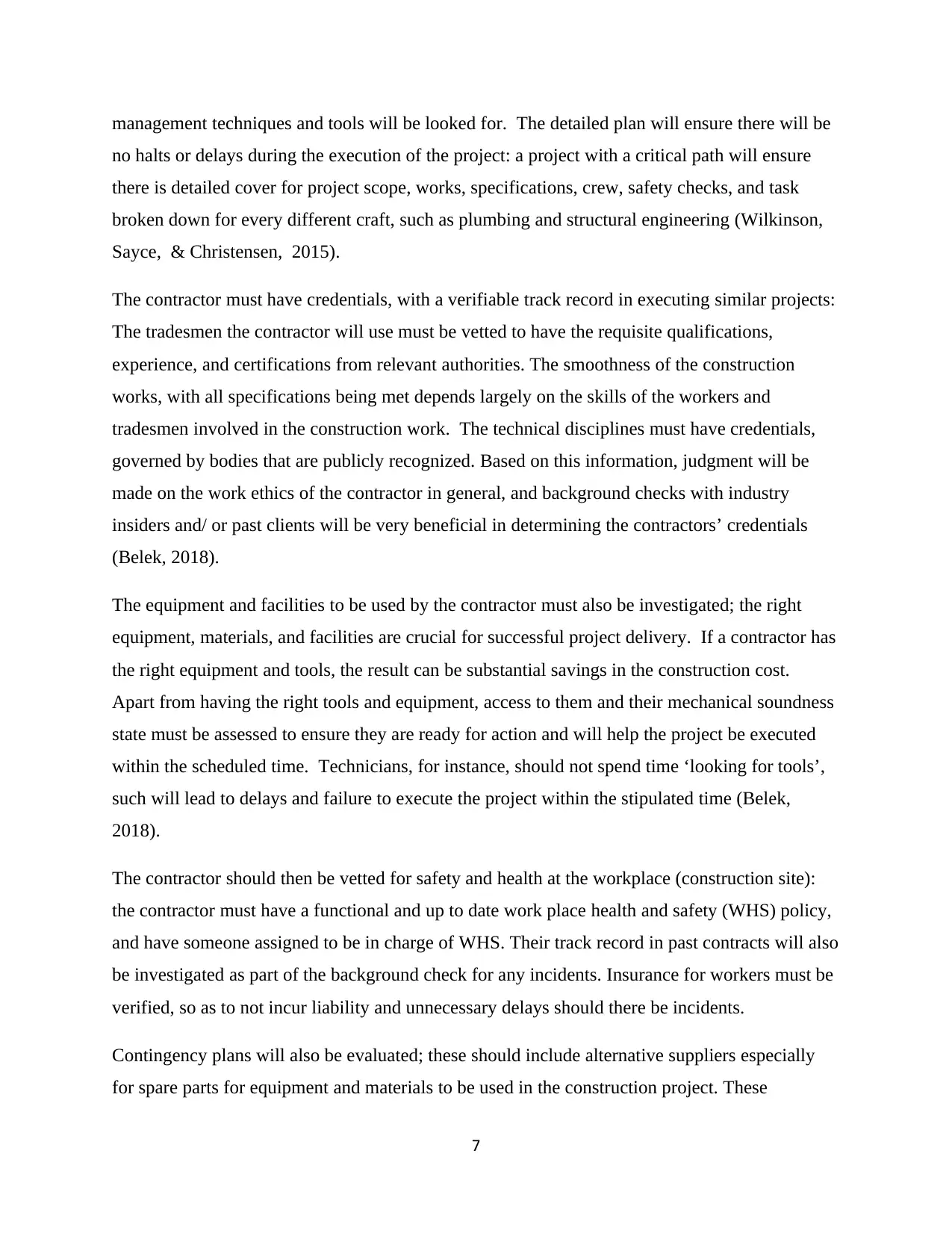
management techniques and tools will be looked for. The detailed plan will ensure there will be
no halts or delays during the execution of the project: a project with a critical path will ensure
there is detailed cover for project scope, works, specifications, crew, safety checks, and task
broken down for every different craft, such as plumbing and structural engineering (Wilkinson,
Sayce, & Christensen, 2015).
The contractor must have credentials, with a verifiable track record in executing similar projects:
The tradesmen the contractor will use must be vetted to have the requisite qualifications,
experience, and certifications from relevant authorities. The smoothness of the construction
works, with all specifications being met depends largely on the skills of the workers and
tradesmen involved in the construction work. The technical disciplines must have credentials,
governed by bodies that are publicly recognized. Based on this information, judgment will be
made on the work ethics of the contractor in general, and background checks with industry
insiders and/ or past clients will be very beneficial in determining the contractors’ credentials
(Belek, 2018).
The equipment and facilities to be used by the contractor must also be investigated; the right
equipment, materials, and facilities are crucial for successful project delivery. If a contractor has
the right equipment and tools, the result can be substantial savings in the construction cost.
Apart from having the right tools and equipment, access to them and their mechanical soundness
state must be assessed to ensure they are ready for action and will help the project be executed
within the scheduled time. Technicians, for instance, should not spend time ‘looking for tools’,
such will lead to delays and failure to execute the project within the stipulated time (Belek,
2018).
The contractor should then be vetted for safety and health at the workplace (construction site):
the contractor must have a functional and up to date work place health and safety (WHS) policy,
and have someone assigned to be in charge of WHS. Their track record in past contracts will also
be investigated as part of the background check for any incidents. Insurance for workers must be
verified, so as to not incur liability and unnecessary delays should there be incidents.
Contingency plans will also be evaluated; these should include alternative suppliers especially
for spare parts for equipment and materials to be used in the construction project. These
7
no halts or delays during the execution of the project: a project with a critical path will ensure
there is detailed cover for project scope, works, specifications, crew, safety checks, and task
broken down for every different craft, such as plumbing and structural engineering (Wilkinson,
Sayce, & Christensen, 2015).
The contractor must have credentials, with a verifiable track record in executing similar projects:
The tradesmen the contractor will use must be vetted to have the requisite qualifications,
experience, and certifications from relevant authorities. The smoothness of the construction
works, with all specifications being met depends largely on the skills of the workers and
tradesmen involved in the construction work. The technical disciplines must have credentials,
governed by bodies that are publicly recognized. Based on this information, judgment will be
made on the work ethics of the contractor in general, and background checks with industry
insiders and/ or past clients will be very beneficial in determining the contractors’ credentials
(Belek, 2018).
The equipment and facilities to be used by the contractor must also be investigated; the right
equipment, materials, and facilities are crucial for successful project delivery. If a contractor has
the right equipment and tools, the result can be substantial savings in the construction cost.
Apart from having the right tools and equipment, access to them and their mechanical soundness
state must be assessed to ensure they are ready for action and will help the project be executed
within the scheduled time. Technicians, for instance, should not spend time ‘looking for tools’,
such will lead to delays and failure to execute the project within the stipulated time (Belek,
2018).
The contractor should then be vetted for safety and health at the workplace (construction site):
the contractor must have a functional and up to date work place health and safety (WHS) policy,
and have someone assigned to be in charge of WHS. Their track record in past contracts will also
be investigated as part of the background check for any incidents. Insurance for workers must be
verified, so as to not incur liability and unnecessary delays should there be incidents.
Contingency plans will also be evaluated; these should include alternative suppliers especially
for spare parts for equipment and materials to be used in the construction project. These
7
Paraphrase This Document
Need a fresh take? Get an instant paraphrase of this document with our AI Paraphraser
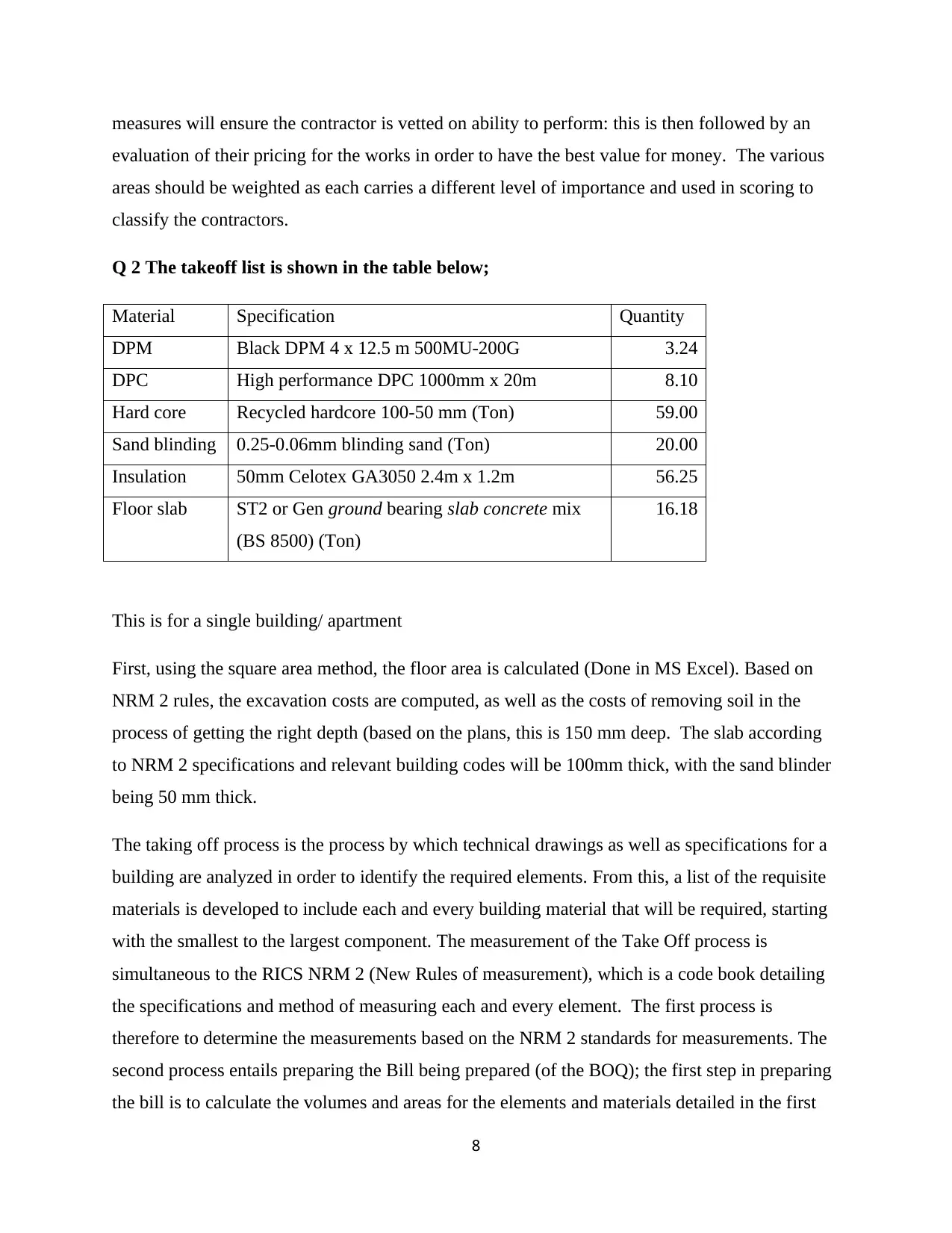
measures will ensure the contractor is vetted on ability to perform: this is then followed by an
evaluation of their pricing for the works in order to have the best value for money. The various
areas should be weighted as each carries a different level of importance and used in scoring to
classify the contractors.
Q 2 The takeoff list is shown in the table below;
Material Specification Quantity
DPM Black DPM 4 x 12.5 m 500MU-200G 3.24
DPC High performance DPC 1000mm x 20m 8.10
Hard core Recycled hardcore 100-50 mm (Ton) 59.00
Sand blinding 0.25-0.06mm blinding sand (Ton) 20.00
Insulation 50mm Celotex GA3050 2.4m x 1.2m 56.25
Floor slab ST2 or Gen ground bearing slab concrete mix
(BS 8500) (Ton)
16.18
This is for a single building/ apartment
First, using the square area method, the floor area is calculated (Done in MS Excel). Based on
NRM 2 rules, the excavation costs are computed, as well as the costs of removing soil in the
process of getting the right depth (based on the plans, this is 150 mm deep. The slab according
to NRM 2 specifications and relevant building codes will be 100mm thick, with the sand blinder
being 50 mm thick.
The taking off process is the process by which technical drawings as well as specifications for a
building are analyzed in order to identify the required elements. From this, a list of the requisite
materials is developed to include each and every building material that will be required, starting
with the smallest to the largest component. The measurement of the Take Off process is
simultaneous to the RICS NRM 2 (New Rules of measurement), which is a code book detailing
the specifications and method of measuring each and every element. The first process is
therefore to determine the measurements based on the NRM 2 standards for measurements. The
second process entails preparing the Bill being prepared (of the BOQ); the first step in preparing
the bill is to calculate the volumes and areas for the elements and materials detailed in the first
8
evaluation of their pricing for the works in order to have the best value for money. The various
areas should be weighted as each carries a different level of importance and used in scoring to
classify the contractors.
Q 2 The takeoff list is shown in the table below;
Material Specification Quantity
DPM Black DPM 4 x 12.5 m 500MU-200G 3.24
DPC High performance DPC 1000mm x 20m 8.10
Hard core Recycled hardcore 100-50 mm (Ton) 59.00
Sand blinding 0.25-0.06mm blinding sand (Ton) 20.00
Insulation 50mm Celotex GA3050 2.4m x 1.2m 56.25
Floor slab ST2 or Gen ground bearing slab concrete mix
(BS 8500) (Ton)
16.18
This is for a single building/ apartment
First, using the square area method, the floor area is calculated (Done in MS Excel). Based on
NRM 2 rules, the excavation costs are computed, as well as the costs of removing soil in the
process of getting the right depth (based on the plans, this is 150 mm deep. The slab according
to NRM 2 specifications and relevant building codes will be 100mm thick, with the sand blinder
being 50 mm thick.
The taking off process is the process by which technical drawings as well as specifications for a
building are analyzed in order to identify the required elements. From this, a list of the requisite
materials is developed to include each and every building material that will be required, starting
with the smallest to the largest component. The measurement of the Take Off process is
simultaneous to the RICS NRM 2 (New Rules of measurement), which is a code book detailing
the specifications and method of measuring each and every element. The first process is
therefore to determine the measurements based on the NRM 2 standards for measurements. The
second process entails preparing the Bill being prepared (of the BOQ); the first step in preparing
the bill is to calculate the volumes and areas for the elements and materials detailed in the first
8
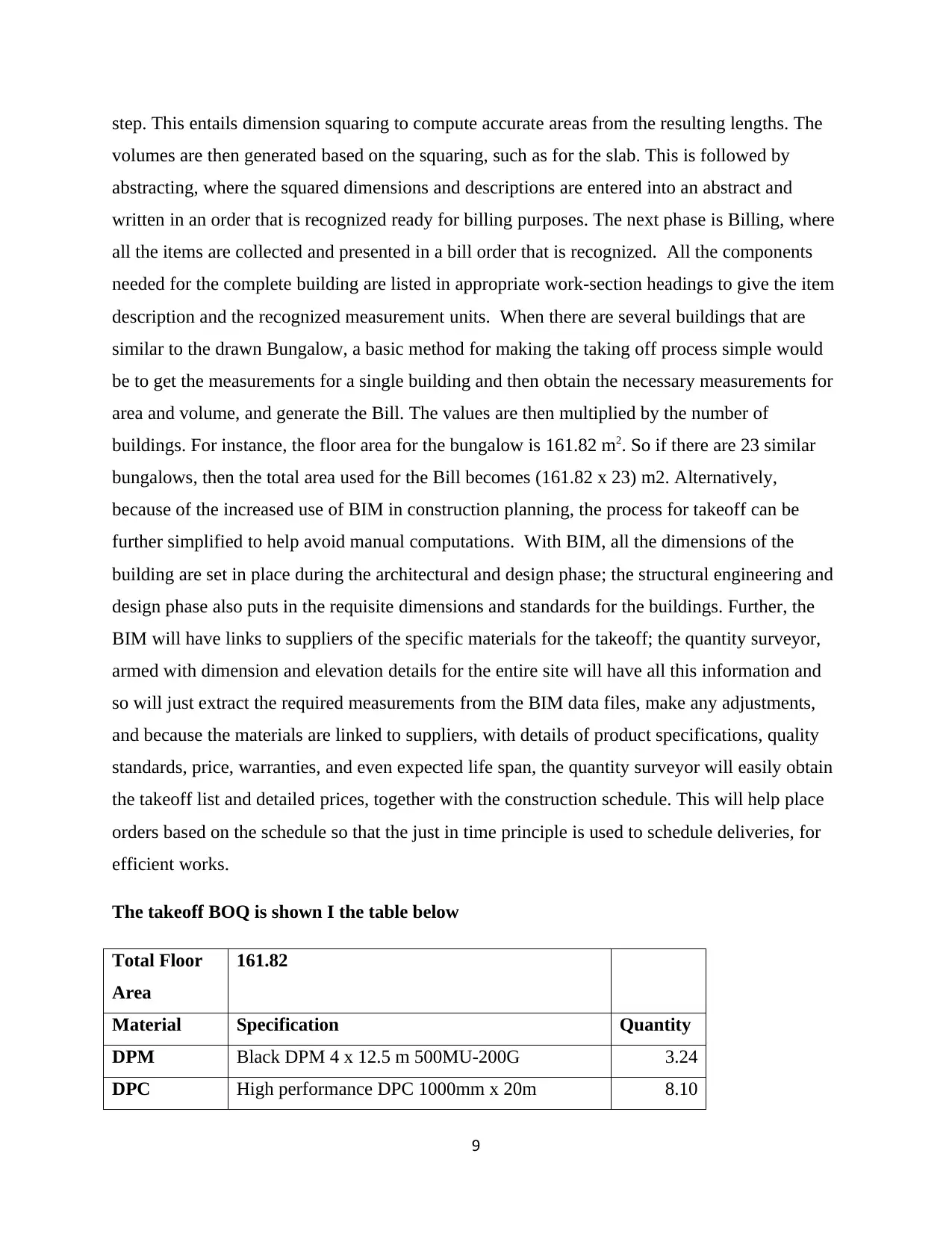
step. This entails dimension squaring to compute accurate areas from the resulting lengths. The
volumes are then generated based on the squaring, such as for the slab. This is followed by
abstracting, where the squared dimensions and descriptions are entered into an abstract and
written in an order that is recognized ready for billing purposes. The next phase is Billing, where
all the items are collected and presented in a bill order that is recognized. All the components
needed for the complete building are listed in appropriate work-section headings to give the item
description and the recognized measurement units. When there are several buildings that are
similar to the drawn Bungalow, a basic method for making the taking off process simple would
be to get the measurements for a single building and then obtain the necessary measurements for
area and volume, and generate the Bill. The values are then multiplied by the number of
buildings. For instance, the floor area for the bungalow is 161.82 m2. So if there are 23 similar
bungalows, then the total area used for the Bill becomes (161.82 x 23) m2. Alternatively,
because of the increased use of BIM in construction planning, the process for takeoff can be
further simplified to help avoid manual computations. With BIM, all the dimensions of the
building are set in place during the architectural and design phase; the structural engineering and
design phase also puts in the requisite dimensions and standards for the buildings. Further, the
BIM will have links to suppliers of the specific materials for the takeoff; the quantity surveyor,
armed with dimension and elevation details for the entire site will have all this information and
so will just extract the required measurements from the BIM data files, make any adjustments,
and because the materials are linked to suppliers, with details of product specifications, quality
standards, price, warranties, and even expected life span, the quantity surveyor will easily obtain
the takeoff list and detailed prices, together with the construction schedule. This will help place
orders based on the schedule so that the just in time principle is used to schedule deliveries, for
efficient works.
The takeoff BOQ is shown I the table below
Total Floor
Area
161.82
Material Specification Quantity
DPM Black DPM 4 x 12.5 m 500MU-200G 3.24
DPC High performance DPC 1000mm x 20m 8.10
9
volumes are then generated based on the squaring, such as for the slab. This is followed by
abstracting, where the squared dimensions and descriptions are entered into an abstract and
written in an order that is recognized ready for billing purposes. The next phase is Billing, where
all the items are collected and presented in a bill order that is recognized. All the components
needed for the complete building are listed in appropriate work-section headings to give the item
description and the recognized measurement units. When there are several buildings that are
similar to the drawn Bungalow, a basic method for making the taking off process simple would
be to get the measurements for a single building and then obtain the necessary measurements for
area and volume, and generate the Bill. The values are then multiplied by the number of
buildings. For instance, the floor area for the bungalow is 161.82 m2. So if there are 23 similar
bungalows, then the total area used for the Bill becomes (161.82 x 23) m2. Alternatively,
because of the increased use of BIM in construction planning, the process for takeoff can be
further simplified to help avoid manual computations. With BIM, all the dimensions of the
building are set in place during the architectural and design phase; the structural engineering and
design phase also puts in the requisite dimensions and standards for the buildings. Further, the
BIM will have links to suppliers of the specific materials for the takeoff; the quantity surveyor,
armed with dimension and elevation details for the entire site will have all this information and
so will just extract the required measurements from the BIM data files, make any adjustments,
and because the materials are linked to suppliers, with details of product specifications, quality
standards, price, warranties, and even expected life span, the quantity surveyor will easily obtain
the takeoff list and detailed prices, together with the construction schedule. This will help place
orders based on the schedule so that the just in time principle is used to schedule deliveries, for
efficient works.
The takeoff BOQ is shown I the table below
Total Floor
Area
161.82
Material Specification Quantity
DPM Black DPM 4 x 12.5 m 500MU-200G 3.24
DPC High performance DPC 1000mm x 20m 8.10
9
⊘ This is a preview!⊘
Do you want full access?
Subscribe today to unlock all pages.

Trusted by 1+ million students worldwide
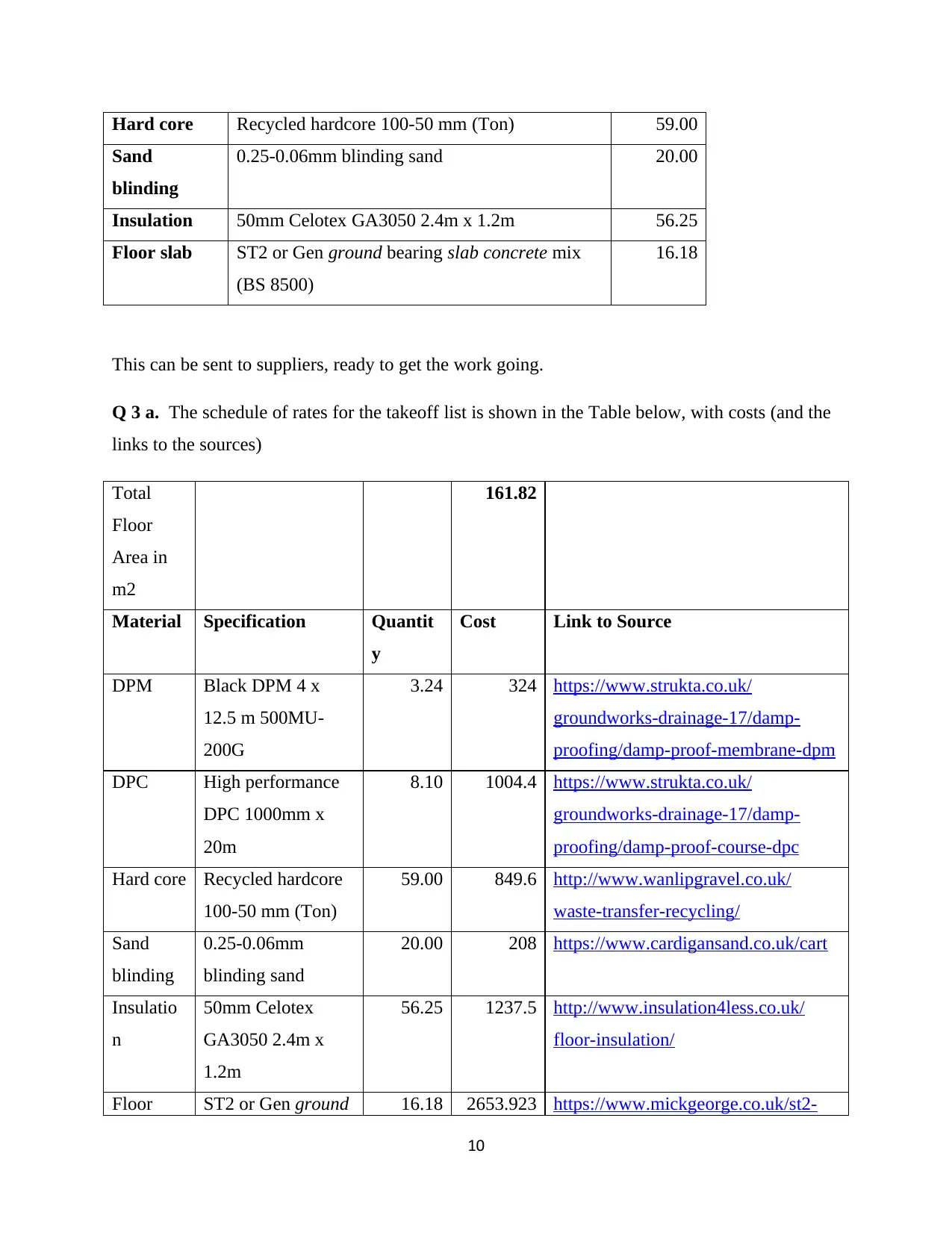
Hard core Recycled hardcore 100-50 mm (Ton) 59.00
Sand
blinding
0.25-0.06mm blinding sand 20.00
Insulation 50mm Celotex GA3050 2.4m x 1.2m 56.25
Floor slab ST2 or Gen ground bearing slab concrete mix
(BS 8500)
16.18
This can be sent to suppliers, ready to get the work going.
Q 3 a. The schedule of rates for the takeoff list is shown in the Table below, with costs (and the
links to the sources)
Total
Floor
Area in
m2
161.82
Material Specification Quantit
y
Cost Link to Source
DPM Black DPM 4 x
12.5 m 500MU-
200G
3.24 324 https://www.strukta.co.uk/
groundworks-drainage-17/damp-
proofing/damp-proof-membrane-dpm
DPC High performance
DPC 1000mm x
20m
8.10 1004.4 https://www.strukta.co.uk/
groundworks-drainage-17/damp-
proofing/damp-proof-course-dpc
Hard core Recycled hardcore
100-50 mm (Ton)
59.00 849.6 http://www.wanlipgravel.co.uk/
waste-transfer-recycling/
Sand
blinding
0.25-0.06mm
blinding sand
20.00 208 https://www.cardigansand.co.uk/cart
Insulatio
n
50mm Celotex
GA3050 2.4m x
1.2m
56.25 1237.5 http://www.insulation4less.co.uk/
floor-insulation/
Floor ST2 or Gen ground 16.18 2653.923 https://www.mickgeorge.co.uk/st2-
10
Sand
blinding
0.25-0.06mm blinding sand 20.00
Insulation 50mm Celotex GA3050 2.4m x 1.2m 56.25
Floor slab ST2 or Gen ground bearing slab concrete mix
(BS 8500)
16.18
This can be sent to suppliers, ready to get the work going.
Q 3 a. The schedule of rates for the takeoff list is shown in the Table below, with costs (and the
links to the sources)
Total
Floor
Area in
m2
161.82
Material Specification Quantit
y
Cost Link to Source
DPM Black DPM 4 x
12.5 m 500MU-
200G
3.24 324 https://www.strukta.co.uk/
groundworks-drainage-17/damp-
proofing/damp-proof-membrane-dpm
DPC High performance
DPC 1000mm x
20m
8.10 1004.4 https://www.strukta.co.uk/
groundworks-drainage-17/damp-
proofing/damp-proof-course-dpc
Hard core Recycled hardcore
100-50 mm (Ton)
59.00 849.6 http://www.wanlipgravel.co.uk/
waste-transfer-recycling/
Sand
blinding
0.25-0.06mm
blinding sand
20.00 208 https://www.cardigansand.co.uk/cart
Insulatio
n
50mm Celotex
GA3050 2.4m x
1.2m
56.25 1237.5 http://www.insulation4less.co.uk/
floor-insulation/
Floor ST2 or Gen ground 16.18 2653.923 https://www.mickgeorge.co.uk/st2-
10
Paraphrase This Document
Need a fresh take? Get an instant paraphrase of this document with our AI Paraphraser

slab bearing slab
concrete mix (BS
8500)
s2-consistence.html
11
concrete mix (BS
8500)
s2-consistence.html
11
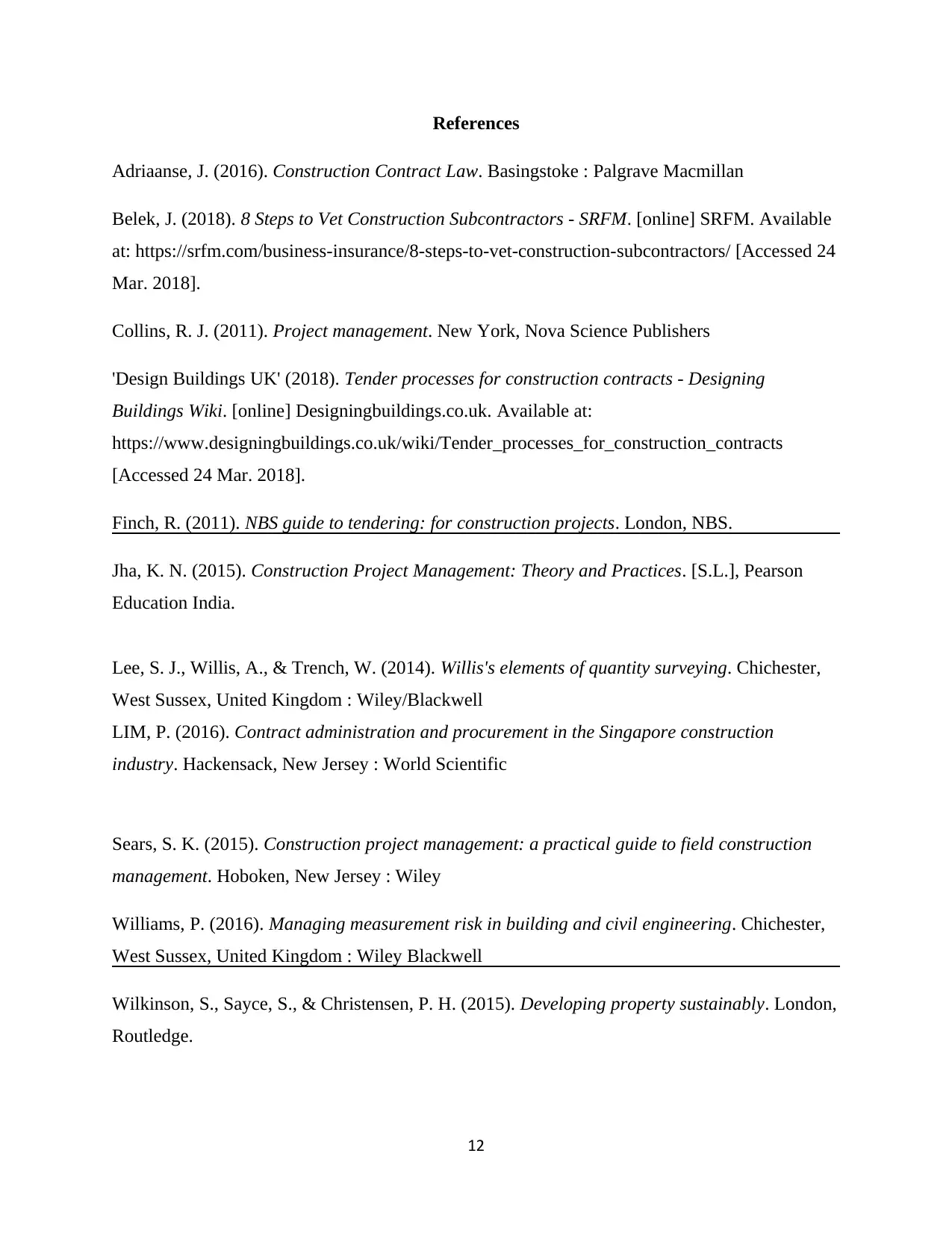
References
Adriaanse, J. (2016). Construction Contract Law. Basingstoke : Palgrave Macmillan
Belek, J. (2018). 8 Steps to Vet Construction Subcontractors - SRFM. [online] SRFM. Available
at: https://srfm.com/business-insurance/8-steps-to-vet-construction-subcontractors/ [Accessed 24
Mar. 2018].
Collins, R. J. (2011). Project management. New York, Nova Science Publishers
'Design Buildings UK' (2018). Tender processes for construction contracts - Designing
Buildings Wiki. [online] Designingbuildings.co.uk. Available at:
https://www.designingbuildings.co.uk/wiki/Tender_processes_for_construction_contracts
[Accessed 24 Mar. 2018].
Finch, R. (2011). NBS guide to tendering: for construction projects. London, NBS.
Jha, K. N. (2015). Construction Project Management: Theory and Practices. [S.L.], Pearson
Education India.
Lee, S. J., Willis, A., & Trench, W. (2014). Willis's elements of quantity surveying. Chichester,
West Sussex, United Kingdom : Wiley/Blackwell
LIM, P. (2016). Contract administration and procurement in the Singapore construction
industry. Hackensack, New Jersey : World Scientific
Sears, S. K. (2015). Construction project management: a practical guide to field construction
management. Hoboken, New Jersey : Wiley
Williams, P. (2016). Managing measurement risk in building and civil engineering. Chichester,
West Sussex, United Kingdom : Wiley Blackwell
Wilkinson, S., Sayce, S., & Christensen, P. H. (2015). Developing property sustainably. London,
Routledge.
12
Adriaanse, J. (2016). Construction Contract Law. Basingstoke : Palgrave Macmillan
Belek, J. (2018). 8 Steps to Vet Construction Subcontractors - SRFM. [online] SRFM. Available
at: https://srfm.com/business-insurance/8-steps-to-vet-construction-subcontractors/ [Accessed 24
Mar. 2018].
Collins, R. J. (2011). Project management. New York, Nova Science Publishers
'Design Buildings UK' (2018). Tender processes for construction contracts - Designing
Buildings Wiki. [online] Designingbuildings.co.uk. Available at:
https://www.designingbuildings.co.uk/wiki/Tender_processes_for_construction_contracts
[Accessed 24 Mar. 2018].
Finch, R. (2011). NBS guide to tendering: for construction projects. London, NBS.
Jha, K. N. (2015). Construction Project Management: Theory and Practices. [S.L.], Pearson
Education India.
Lee, S. J., Willis, A., & Trench, W. (2014). Willis's elements of quantity surveying. Chichester,
West Sussex, United Kingdom : Wiley/Blackwell
LIM, P. (2016). Contract administration and procurement in the Singapore construction
industry. Hackensack, New Jersey : World Scientific
Sears, S. K. (2015). Construction project management: a practical guide to field construction
management. Hoboken, New Jersey : Wiley
Williams, P. (2016). Managing measurement risk in building and civil engineering. Chichester,
West Sussex, United Kingdom : Wiley Blackwell
Wilkinson, S., Sayce, S., & Christensen, P. H. (2015). Developing property sustainably. London,
Routledge.
12
⊘ This is a preview!⊘
Do you want full access?
Subscribe today to unlock all pages.

Trusted by 1+ million students worldwide
1 out of 12
Related Documents
Your All-in-One AI-Powered Toolkit for Academic Success.
+13062052269
info@desklib.com
Available 24*7 on WhatsApp / Email
![[object Object]](/_next/static/media/star-bottom.7253800d.svg)
Unlock your academic potential
Copyright © 2020–2025 A2Z Services. All Rights Reserved. Developed and managed by ZUCOL.





